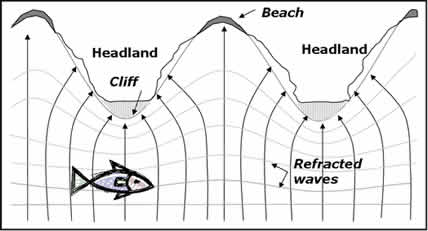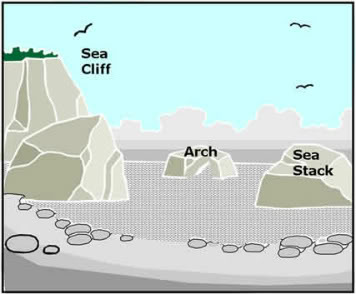 On the windswept shores of the Olympic Peninsula lies Ruby Beach, named for the rose-colored garnet fragments found in the coarse gray sand. This rugged, often fogged-in shoreline is part of Olympic National Park. What makes Ruby Beach visually so stunning is the presence of rocky formations known as "sea stacks."
On the windswept shores of the Olympic Peninsula lies Ruby Beach, named for the rose-colored garnet fragments found in the coarse gray sand. This rugged, often fogged-in shoreline is part of Olympic National Park. What makes Ruby Beach visually so stunning is the presence of rocky formations known as "sea stacks."
What is a Sea Stack?
Isolated outcrops of rock standing in the ocean are called sea stacks, and they are remnants of rocky headlands that were eroded by wave action. Stacks are easy to recognize because they stand alone, no longer attached to the cliffs. At high tide they will usually be tall rocks rising from the sea just off the shore, though at low tide you may be able to walk out to them across the beach.
How are they formed?
The Washington coastline naturally has areas of rocky headlands alternating with sandy coves due to variation in the local rock types. As waves approach the shore, they are refracted nearly parallel to shore so that wave energy is concentrated on headlands. Rocky cliffs develop on the headlands and sand is deposited in the bays, forming beaches. Through this process of erosion and deposition, an irregularly shaped coastline will be gradually straightened.

In the cliffs that form the headlands, there are areas that are more fractured or have inclusions of softer rocks. Breaking waves exploit the fractures by pounding them with loose pebbles and forcing air into them. Wave action will erode weak areas more quickly, isolating outcrops of more resistant rocks to make sea stacks. You see sea stacks concentrated at the end of rocky ridges and headlands, marking where a ridge projected as a headland.

When a weakness in an exposed headland becomes a cave, the cave is enlarged from both ends to form an arch, and finally the top of the arch collapses leaving the seaward pillar (the upright bit nearest the sea) as a stack.

The presence of isolated stacks may indicate a change in the type of rock forming the cliff line. For example, a volcanic intrusion or a lava flow may be much more resistant to erosion than the surrounding rocks. Over time the softer rocks erode away leaving a strip of much more resistant rock exposed to the sea. Harder rocks will stay around longer, increasing the chances of the rock remaining long enough for a stack to be formed. You can deduce from this that very soft and easily eroded rocks are unlikely to form a stack because they will not withstand the action of the sea for a long enough period of time.
Over time, all stacks are worn down. A stack that has been reduced to a short pillar is known as a stump. Stumps may be hidden at high tide and only become visible as the tide goes out.

To qualify as a "find", email, (do not post online), the answers to the following questions. Please send your answers at the same time you log your find. Failure to due that in a timely manner will result in a log deletion.
Visit the interpretive sign at WP 1 and answer the following question:
1) What are the names of the ocean birds listed on the sign who benefit from the sea stacks?
Now hike down to the posted coordinates.
2) The sea stack located here is different in appearance than its neighbors. How is it different and in your opinion why?.
Mandatory Post a picture of you or your GPSr with some of the sea stacks to your log. We hope you have learned a thing or two about sea stacks and thanks for visiting the Olympic National Park.
 |
Warning: Earthcaches come with a unique set of rules and activities that must be met
before successfully logging. Failure to comply will result in a log deletion.
|
|